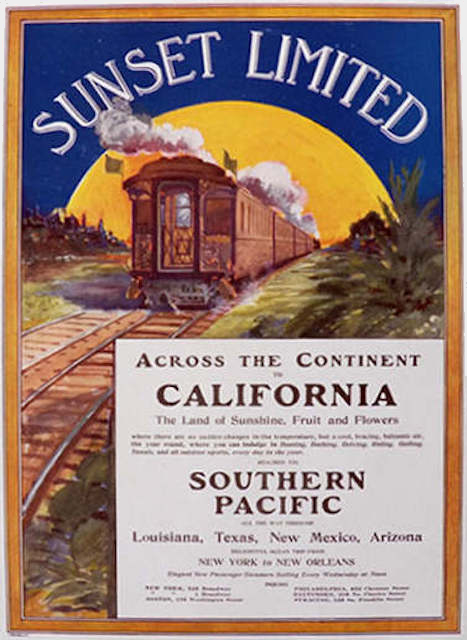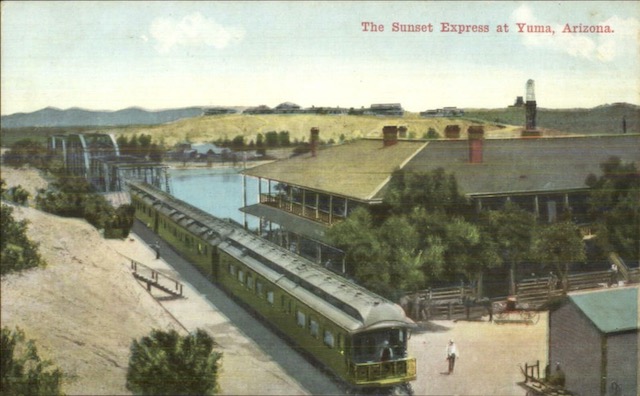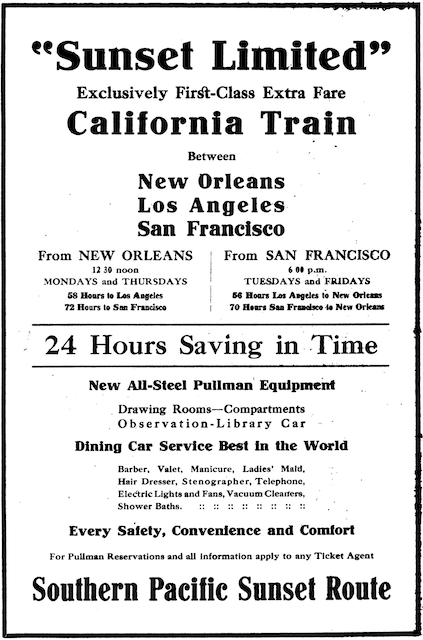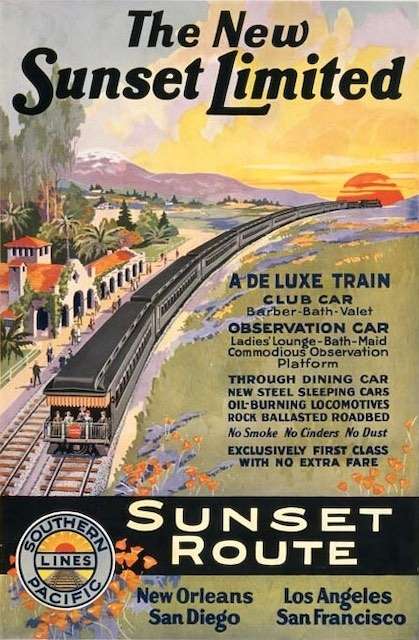As the Santa Fe was growing its service to Los Angeles from Chicago, the Southern Pacific was expanding its own service between Los Angeles and New Orleans. While Wikipedia and other web sites seem to be confused about the railroad’s history in this corridor, the Official Guides from the 1880s through the 1910s provide some answers.
 This ad or poster is for the original Sunset Limited before it was discontinued in 1904.
This ad or poster is for the original Sunset Limited before it was discontinued in 1904.
Southern Pacific completed its line from New Orleans to Los Angeles on January 12, 1883. By 1884, SP was running two trains a day from New Orleans to El Paso and two from El Paso to Los Angeles, timed to have about three hour layovers to change trains in El Paso. The whole trip took about 110 hours with trains stopping at more than 300 cities and towns between New Orleans and Los Angeles.
In January 1890, SP for the first time began running through trains all the way from New Orleans to Los Angeles. This was about a year before Santa Fe first offered through trains between Chicago and L.A. The trains were unnamed and just listed as “Express” in the timetables, meaning they stopped only about 200 times instead of more than 300 and took about 100 hours each way.
In May 1894, SP applied numbers to the trains in its timetables for the first time. The trains between Los Angeles and New Orleans were numbered 18 & 19.
On November 1, 1895, SP inaugurated the Sunset Limited. It was a true limited, making fewer than 30 stops between its terminal cities, thus reducing its time to about 74 hours. It initially had no number and was designated “Lim” in the timetables where there would otherwise be a train number.
The original Sunset Limited operated only once a week. It also operated only in the winter months, as it appeared in official guides for January and March but not for May and July. Although the Official Guides don’t say so, I’m pretty sure it was an all-Pullman train.
The frequency was boosted to two trains a week in the winter of 1899. Also, the train was numbered 1001 and 1002. This was short lived, however, as the train was numbered 25 and 26 in 1900, when it operated three times a week. Whatever the numbers, it was still an all-first-class train.
On November 15, 1902, Southern Pacific made the Sunset Limited a daily train, renumbering it 9 & 10. Moreover, it operated during the summer for the first time in 1903. However, it made many more stops than the 1895 train. It also lost its first-class status, as it now carried chair cars. In fact, for a time it was the only passenger train operating all the way from either San Francisco or Los Angeles to New Orleans.

Various incarnations of this postcard label the train as the Sunset Express, Sunset Limited, and Overland Limited. It’s obviously not the Overland, which never went anywhere near Yuma, and it’s not the pre-1904 Sunset Limited, as the postcards have divided backs that only became legal in 1907. My guess is that the train is the Sunset Express taken before 1911, and then after the Sunset Limited was reinaugurated, the photo was labeled for that train. Click image to download a 165-KB PDF of this postcard.
Then, on May 31, 1904, Southern Pacific suddenly discontinued the train, replacing it with a train called the Sunset Express, numbered 11 & 12. It was daily and used the newly opened Coast Route between San Francisco and Los Angeles, requiring about 73 hours to make the distance between San Francisco and New Orleans. In January 1905, the Sunset Express was renumbered 9 & 10, which had previously been used for the Sunset Limited. Perhaps the SP changed the name because of the downgrade from a true limited serving only first-class passengers to merely an express train open to coach passengers.
 Click image to view this article from the Newcastle News in a larger, readable format.
Click image to view this article from the Newcastle News in a larger, readable format.
On December 13, 1911, the Newcastle [California] News reported that the Southern Pacific had “reinaugurated” its “famous train,” the Sunset Limited, on “Tuesday past” (meaning December 5). The all-steel, all-Pullman train offered “stenographers, valets, barbers, telephones, special mail boxes, daily stock reports and the like” for “the busy man” and “maids, manicures, hair dressers, electric fans, writing rooms and an elaborate array of current magazines, popular fiction” for the ladies, plus shower baths, electric lights, and much more for everyone.
 Click image for a larger view.
Click image for a larger view.
Southern Pacific took the unusual (for it) step of placing a full-page ad in the Official Guide for January 1912 announcing the “exclusively first-class extra fare” Sunset Limited, operating twice a week with all-steel equipment. For the first time, the Sunset Express, trains 9 & 10, and the Sunset Limited, once again numbered 1001 and 1002, appeared on the same timetable.
 This poster has been dated to 1924. Click image for a larger view.
This poster has been dated to 1924. Click image for a larger view.
The Sunset Limited was once again a true limited, making only around three dozen stops between San Francisco and New Orleans. The Sunset Express made many more stops but still skipped some towns. A third pair of daily trains, numbered 7 and 8, were also available and stopped just about everywhere along the way. The Sunset Limited took just over 70 hours to New Orleans; the Express took about 100; and #8 took around 115.
Both the Limited and Express would stay on the timetable through the early 1920s, though the Limited was renumbered 101 and 102 and the Express was renumbered 109 and 110. In 1926, the Express would be dropped in favor of the Argonaut, which was numbered 103 and 104.
I am sure it was no coincidence that the new Sunset Limited was reinaugurated a mere week before Santa Fe introduced its de-Luxe, with the first train departing New Orleans on December 4 and San Francisco December 5. Southern Pacific used “de luxe” at least twice in the press release that no doubt inspired the Newcastle News article. The term also appeared in Sunset Limited advertising after 1911 but not in ads from 1904 or before.
Initially, the new Sunset Limited was just five cars long: a baggage car with a dynamo to run the electric lights on the train; two 12-section, 1-drawing room cars; a dining car; and a six-compartment, 1-drawing room, observation car. The dominance of sections shows that the train wasn’t as exclusive as the de Luxe. Yet the train was so successful that, as of November 16, 1913, it was made a daily and a tourist sleeping car was added that came from or went to Washington, DC, allowing people to go from the Atlantic to the Pacific without changing trains. It must have made a few more stops as it took around 74 hours to get from San Francisco to New Orleans and 76 the other way.
